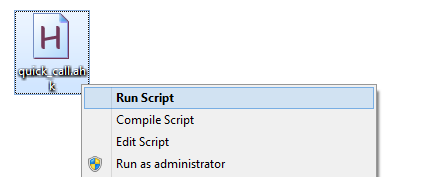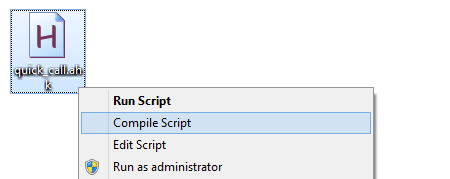¶ gloCOM Quick Call
¶ Quick Call Windows Guide
WARNING:This functionality depends on a third party application that is not directly supported by Bicom Systems.
Call selected numbers in any Windows application with a single button press.
Using a combination of keyboard keys (ie. Ctrl + G, Ctrl + Shift + O) or by simply pressing an F key (ie. F6) initiate a call of the selected phone number from any application using gloCOM. More complex key combinations can be assigned to keyboard Macro keys in order to avoid clashing with application shortcuts that are already taken.
Quick call functionality can be set up using an open source application AutoHotkey available on GitHub at:
https://github.com/Lexikos/AutoHotkey_L
AutoHotkey source code on Github is public and auditable which help alleviate security concerns caused by applications like this.
¶ Installation
Download the latest AutoHotkey_setup.exe setup from:
https://github.com/Lexikos/AutoHotkey_L/releases/latest and install it.
¶ Macro Script
After installing AutoHotkey create a file with name "quick_call.ahk" and paste into it one of the script examples from below:
Example with F6 key:
F6::
Send, ^c
ClipWait, 2
if ErrorLevel
{
MsgBox, The attempt to copy text onto the clipboard failed.
return
}
Run, open glocom://%clipboard%
return
Example with Control, Shift, O :
^+o::
Send, ^c
ClipWait, 2
if ErrorLevel
{
MsgBox, The attempt to copy text onto the clipboard failed.
return
}
Run, open glocom://%clipboard%
return
¶ Testing the script
To test the saved script, right click the "quick_call.ahk" file and choose Run Script as shown in the image below:

The script can be protected from unwanted changes by packaging it as a program by right clicking the "quick_call.ahk" file and choosing Compile Script as shown in the image below:
Compiled Scripts will behave in the same way as regular Scripts without the option to change the Macro shortcut keyboard combination.

While a Script is active a small green AutoHotkey “H” icon will show up in the tray bar as shown in the image below:

¶ Launching on startup
In order for the script to be automatically available on startup add the Script in its protected or regular form to the startup folder on your Windows system.
For Windows versions 8, 8.1 and 10 the startup folder can be found at:
C:\ProgramData\Microsoft\Windows\Start Menu\Programs\StartUp
¶ Where to next?
For more info on AutoHotkey please visit the official help page: